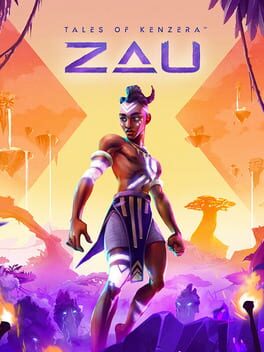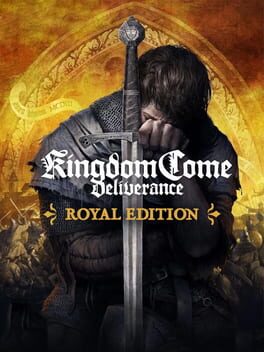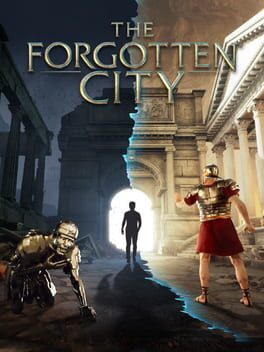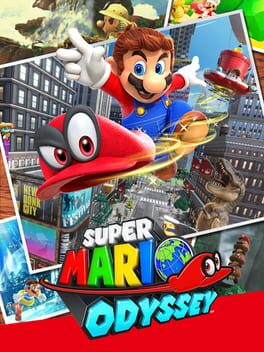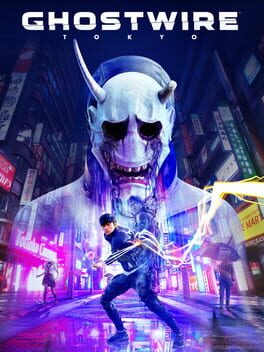AndreyTsvetkov
139 Reviews liked by AndreyTsvetkov
I started the game on one of those nights when I was browsing the entire PS Store and couldn't find anything appealing. I tried ten games one after the other, but none suited my mood. I wanted something fast-paced and dynamic that I could start playing immediately, without long dialogues or cinematic pretensions. Tales of Kenzera: Zau turned out to be exactly what I needed.
Colorful and visually pleasing, the game can easily appeal to gamers like me who aren't necessarily looking for a big challenge. Most of the time, the game feels like a walk in the park, except for the 1-2 moments where it forces you to run from some danger without giving you time to get your bearings (like the lava chase at the end).
However, there are a few drawbacks. The combat units lack variety, with only 4-5 different types to destroy. Additionally, it feels lazy when the game makes you go through a level twice - once in one direction and once in the other.
Overall, I'm satisfied. It gave me a a sense of healthy disengagement that only a solid 6/10 game can offer.
Colorful and visually pleasing, the game can easily appeal to gamers like me who aren't necessarily looking for a big challenge. Most of the time, the game feels like a walk in the park, except for the 1-2 moments where it forces you to run from some danger without giving you time to get your bearings (like the lava chase at the end).
However, there are a few drawbacks. The combat units lack variety, with only 4-5 different types to destroy. Additionally, it feels lazy when the game makes you go through a level twice - once in one direction and once in the other.
Overall, I'm satisfied. It gave me a a sense of healthy disengagement that only a solid 6/10 game can offer.
After a 7 year wait, the sequel to Ninja Theory's cinematic dark fantasy look at psychosis has finally arrived. Xbox has positioned this game as a very high-profile exclusive, as they've proudly showcased it with much fanfare at both their own events as well as at The Game Awards. Unfortunately, Senua's second outing came up a little short for me thanks to its lack of compelling gameplay and inconsistent narrative.
Becoming a big budget Xbox title is an interesting trajectory for this franchise, since the first game was an effort to make a Triple A-esque cinematic experience outside of the studio system. Ninja Theory was tired of trying to meet publisher demands and were just going to do their own thing or die trying. As a result, they got scooped up by Microsoft and Hellblade II is coming at us from a very different angle than last time.
Senua's Saga first and foremost feels like a technical showpiece, with groundbreaking motion and facial capture that really is impressive and photorealistic. The faces looked so good at times that I was caught wondering if the game had switched to live action (a trick Ninja Theory has pulled in the past), but nope, all of this is in-engine. The work that has gone into the performances, as well as the Icelandic landscapes where the game is set can be at times stunning to hold. Of course, the audio design is still fantastic as well and plays as important a role as ever in the story.
Where the first game had Senua coming to grips with her psychosis while also learning to move on from her deceased lover, Hellblade II finds her in an arguably steadier place mentally as she has learned to live with the voices in her head. Hellblade I felt basically felt like a panic attack at all times, but here Senua feels more capable and confident. Resultingly, this game is more focused on Senua meeting some companions and slowly learning to become a leader, while also fearing that she is becoming a ruthless and violent killer. I enjoyed seeing her interact with some new friends and foes through the journey, which makes it all feel less isolated than the first game and a bit more ambitious in scope. That being said, Hellblade II's storyline feels sort of directionless for a good chunk and when it finally starts to coalesce, the game is nearly over.
Gameplay-wise, Hellblade II feels like a step in the wrong direction from its predecessor. You'll still see some of the perspective navigation puzzles as well as the rune matching parts from the previous game, but these are all made easier from the already pretty simple brain teasers you'd find in Hellblade I. I've found the rune puzzles to be tedious in both games but this one will basically just snap you to the solution as long as you're kind of looking in the general area of the right spot. I just think of something like the Plague Tale games where the environmental context of the puzzles are always so compelling and unique- whereas in Hellblade it feels like a forced layer of interactivity so the whole game isn't just a walking sim.
Speaking of which, this game does get closer to walking sim vibes than the first with lengthy sequences where you aren't doing anything other than holding forward or climbing up or down small ledges. There's some walk-and-talk with the companion characters at times but it makes the whole game feel a bit dull at times. It doesn't help that the environments, while pretty, blend together after a while and feel narrow in scope. The visual fidelity of course comes with plenty of tight caves, perfect for the typical wall squeeze animations to hide load times.
Like the perspective puzzles, Hellblade II also simplifies the combat from the first game. You still have your light and heavy attack, parry, and focus meter/special attack, but the rhythm of combat feels a lot different this time. Instead of facing some three, four, or five guys at once, in this game you'll only be going up against one enemy at a time. This choice is definitely to focus in on the excellent motion capture and fight choreography, but the challenge of keeping track of where all of your enemies are to make sure you're not getting jumped from behind has been removed. I read that the main inspiration for the combat was the Jon Snow tracking sequence in the Battle of the Bastards fight in Game of Thrones. There are some really cool moments in this game where you're cinematically clashing with various foes with your companions, though the game craftily makes sure you only need to focus on one guy at once in the context of the fight.
Outside of a few deaths to the annoying fire-throwing enemy type, the combat in this game is extremely easy. The parry window seems shortened or less consistent than in the previous game, but I still had no trouble blocking and dodging throughout. Any boss encounters are against normal human-sized foes, don't expect to go up any great beasts like in the previous game. Overall the combat can be entertaining in moments, but there isn't a lot of variety to it and the game would benefit a lot from adding some more depth here.
Hellblade II feels like the sort of tech demo-ish title that would come out right at a console launch, which is odd for a follow-up for a game about mental health. The game took me less than 7 hours to get through as well, so at a $50 asking price, I can't imagine many people who aren't already GamePass subscribers jumping into this one. This is an odd title to position as a can't-miss Xbox showpiece, and feels like a somewhat emptier and less inspired follow-up to the cult hit of the first game.
Becoming a big budget Xbox title is an interesting trajectory for this franchise, since the first game was an effort to make a Triple A-esque cinematic experience outside of the studio system. Ninja Theory was tired of trying to meet publisher demands and were just going to do their own thing or die trying. As a result, they got scooped up by Microsoft and Hellblade II is coming at us from a very different angle than last time.
Senua's Saga first and foremost feels like a technical showpiece, with groundbreaking motion and facial capture that really is impressive and photorealistic. The faces looked so good at times that I was caught wondering if the game had switched to live action (a trick Ninja Theory has pulled in the past), but nope, all of this is in-engine. The work that has gone into the performances, as well as the Icelandic landscapes where the game is set can be at times stunning to hold. Of course, the audio design is still fantastic as well and plays as important a role as ever in the story.
Where the first game had Senua coming to grips with her psychosis while also learning to move on from her deceased lover, Hellblade II finds her in an arguably steadier place mentally as she has learned to live with the voices in her head. Hellblade I felt basically felt like a panic attack at all times, but here Senua feels more capable and confident. Resultingly, this game is more focused on Senua meeting some companions and slowly learning to become a leader, while also fearing that she is becoming a ruthless and violent killer. I enjoyed seeing her interact with some new friends and foes through the journey, which makes it all feel less isolated than the first game and a bit more ambitious in scope. That being said, Hellblade II's storyline feels sort of directionless for a good chunk and when it finally starts to coalesce, the game is nearly over.
Gameplay-wise, Hellblade II feels like a step in the wrong direction from its predecessor. You'll still see some of the perspective navigation puzzles as well as the rune matching parts from the previous game, but these are all made easier from the already pretty simple brain teasers you'd find in Hellblade I. I've found the rune puzzles to be tedious in both games but this one will basically just snap you to the solution as long as you're kind of looking in the general area of the right spot. I just think of something like the Plague Tale games where the environmental context of the puzzles are always so compelling and unique- whereas in Hellblade it feels like a forced layer of interactivity so the whole game isn't just a walking sim.
Speaking of which, this game does get closer to walking sim vibes than the first with lengthy sequences where you aren't doing anything other than holding forward or climbing up or down small ledges. There's some walk-and-talk with the companion characters at times but it makes the whole game feel a bit dull at times. It doesn't help that the environments, while pretty, blend together after a while and feel narrow in scope. The visual fidelity of course comes with plenty of tight caves, perfect for the typical wall squeeze animations to hide load times.
Like the perspective puzzles, Hellblade II also simplifies the combat from the first game. You still have your light and heavy attack, parry, and focus meter/special attack, but the rhythm of combat feels a lot different this time. Instead of facing some three, four, or five guys at once, in this game you'll only be going up against one enemy at a time. This choice is definitely to focus in on the excellent motion capture and fight choreography, but the challenge of keeping track of where all of your enemies are to make sure you're not getting jumped from behind has been removed. I read that the main inspiration for the combat was the Jon Snow tracking sequence in the Battle of the Bastards fight in Game of Thrones. There are some really cool moments in this game where you're cinematically clashing with various foes with your companions, though the game craftily makes sure you only need to focus on one guy at once in the context of the fight.
Outside of a few deaths to the annoying fire-throwing enemy type, the combat in this game is extremely easy. The parry window seems shortened or less consistent than in the previous game, but I still had no trouble blocking and dodging throughout. Any boss encounters are against normal human-sized foes, don't expect to go up any great beasts like in the previous game. Overall the combat can be entertaining in moments, but there isn't a lot of variety to it and the game would benefit a lot from adding some more depth here.
Hellblade II feels like the sort of tech demo-ish title that would come out right at a console launch, which is odd for a follow-up for a game about mental health. The game took me less than 7 hours to get through as well, so at a $50 asking price, I can't imagine many people who aren't already GamePass subscribers jumping into this one. This is an odd title to position as a can't-miss Xbox showpiece, and feels like a somewhat emptier and less inspired follow-up to the cult hit of the first game.
Lumines
2004
Lumines is a true masterclass in puzzle game design. Every element is so finely tuned, so excellently thought out, so clearly communicated, that it rivals even Tetris in its virtuosity.
It's not nearly as "clean" as Tetris is - but I'd rather play the quirky block game with the wacky timeline and danceable music than the old-man tetromino placer with classical compositions.
It's not nearly as "clean" as Tetris is - but I'd rather play the quirky block game with the wacky timeline and danceable music than the old-man tetromino placer with classical compositions.
Stray
2022
The Forgotten City
2021
PaRappa the Rapper
1996
PaRappa the Rapper
1996
PaRappa the Rapper
1996
Animal Well
2024
Super Mario Odyssey
2017
While engrossed in the game, I had a moment of awe, thinking, 'Wow, what a masterpiece!' The sheer variety and countless hidden details were mind-blowing. However, reflecting two weeks later, I find myself disconnected. Perhaps it's because I spent hours playing the bonus moon levels or perhaps I just don't care about Mario.
